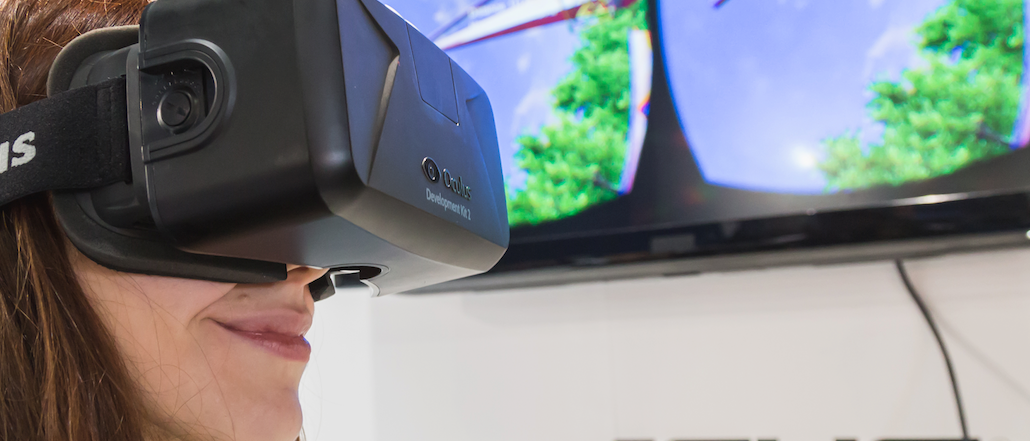
Virtual reality is definitely having a moment in media.
Last month in Cannes, CBS Interactive announced a new virtual reality division, charged with incorporating a VR component into each of its 25 brands. CBS Media Group’s reach extends from CNET and TVGuide.com to Chowhound and TV.com — meaning virtual reality could be positioned to become the hottest new medium in the mass-market consumer entertainment business.
“VR technology is getting closer to delivering a really ‘true to life’ experience,” said Gabe Zichermann, chair of GSummit, a marketing and gaming conference in San Francisco. “As it does, it will revolutionize entertainment and marketing. Games and porn will be first, but over time other entertainment categories will be similarly transformed.”
VR has been having a bit of a broader moment. Last year, social media giant Facebook purchased Oculus VR for a cool $2 billion. At the International Festival of Creativity in Cannes, SapientNitro provided a glimpse into how powerful VR could be for e-commerce and as a marketing research tool. Gartner Group projects 25 million virtual reality headsets will be in consumer hands globally by 2018.
“It will be very popular in the beginning on the consumer side,” said Brian Blau, an analyst at Gartner group who specializes in VR. “It’s the hottest old/new medium. It’s been around for a long time.” The reason its time appears to be coming, said Blau, is that the technology — and pricing — has improved markedly over the past decade.
When VR emerged in 1990s, there was no cloud, color graphics were clunky and there was no Internet ecosystem. Virtual reality required gloves and goggles, and came with a hefty price tag – as a result, it failed to catch on with the general populace.
Virtuality Group produced a VR system in the early ’90s, for example, that required a stand-up arena system and a vehicle cockpit. The headset had built in screens and put gamers in the position of their characters in the game. The price tag: tens of thousands of dollars. Game over.
Apple also made its first VR foray in the ’90s with iGlasses, which featured a headset that trumpeted color stereoscopic 3-D and head tracking: in which visuals moved when the player turned his head. Though iGlasses boasted a price tag under $1000, it failed to capture the public’s imagination. Other VR brands, such as Nintendo Virtual Boy, Stuntmaster, Cybermaxx, and VFX-1, also failed to catch on; keeping VR on the fringe of entertainment, as well as begetting a series of bad VR movies, such Johnny Mnemonic — who could only carry 80 gigabytes of data in his head.
Not only was the tech lacking, but VR needed a branding makeover. That makeover has come in the form of the Facebook/Oculus deal. Mark Zuckerberg has envisioned a system whereby Facebook users could virtually attend a sporting event, go shopping, or visit the doctor. Also jumping into the VR game is Sony with Morpheus, Microsoft, YouTube and, most notably, Google.
Google Cardboard allows an accessible VR experience for under $25: The cardboard headset is designed to use with your smartphone as the screen. Boom – everyone can now have a VR device right in their front pocket. It’s very basic but makes both the user and entertainment companies think differently about 360-degree video as an everyday reality.
And with easy accessibility comes great need for content. Lots of it. It’s already on YouTube’s periphery. Robert Kyncl, head of YouTube’s content and business operations, is excited about VR but also sees it as something that’s going to take a long time to develop.
“We don’t know how long VR is going to take and how large it’s going to be,” Kyncl told the Guardian. “But we know it’s somehow going to play an important role, and we, therefore, must have focus on it and have people working on it.”
Meanwhile, CBS Interactive’s goal is to serve their viewers as well as their base of advertisers. The company’s branded content wing, Studio 61, debuted a comedy short featuring SNL’s Kenan Thompson at Cannes Lions that helped show the potential of virtual reality.
“What’s out there now is a lot of, ‘Let us take you on a virtual tour of farming in Iceland,’” said Christy Tanner, svp and gm of CBS Interactive Media Group. “I personally am really interested to see what the creative community will do with virtual reality.” Tanner told Adweek that the purpose of the comedy short was “to create something that would make you laugh and then serve a dual purpose of providing a how-to: how to do virtual reality.”
Toward that end, CBS Interactive’s first foray was CNET’s virtual reality coverage of E3 2015. We’ve come a long way since the days of Johnny Mnemonic.
Image courtesy of Stefano Tinti / Shutterstock.com
More in Marketing

Best Buy, Lowe’s chief marketing officers explain why they launched new influencer programs
CMOs launched these new programs in response to the growing importance of influencers in recommending products.

Agencies create specialist units to help marketers’ solve for AI search gatekeepers
Wpromote, Kepler and Jellyfish practices aim to illuminate impact of black box LLMs’ understanding of brands search and social efforts.

What AI startup Cluely gets — and ad tech forgets — about attention
Cluely launched a narrative before it launched a tool. And somehow, it’s working.





